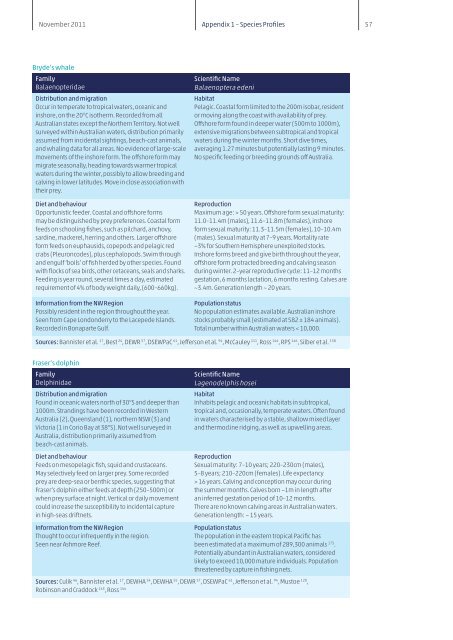Australia's last great whale haven.pdf - Ningaloo Atlas
Australia's last great whale haven.pdf - Ningaloo Atlas
Australia's last great whale haven.pdf - Ningaloo Atlas
- TAGS
- whale
- ningaloo
- atlas
- www.ifaw.org
Create successful ePaper yourself
Turn your PDF publications into a flip-book with our unique Google optimized e-Paper software.
November 2011 Appendix 1 – Species Profiles<br />
57<br />
Bryde’s <strong>whale</strong><br />
Family<br />
Balaenopteridae<br />
Distribution and migration<br />
Occur in temperate to tropical waters, oceanic and<br />
inshore, on the 20°C isotherm. Recorded from all<br />
Australian states except the Northern Territory. Not well<br />
surveyed within Australian waters, distribution primarily<br />
assumed from incidental sightings, beach-cast animals,<br />
and whaling data for all areas. No evidence of large-scale<br />
movements of the inshore form. The offshore form may<br />
migrate seasonally, heading towards warmer tropical<br />
waters during the winter, possibly to allow breeding and<br />
calving in lower latitudes. Move in close association with<br />
their prey.<br />
Diet and behaviour<br />
Opportunistic feeder. Coastal and offshore forms<br />
may be distinguished by prey preferences. Coastal form<br />
feeds on schooling fishes, such as pilchard, anchovy,<br />
sardine, mackerel, herring and others. Larger offshore<br />
form feeds on euphausids, copepods and pelagic red<br />
crabs (Pleuroncodes), plus cephalopods. Swim through<br />
and engulf ‘boils’ of fish herded by other species. Found<br />
with flocks of sea birds, other cetaceans, seals and sharks.<br />
Feeding is year round, several times a day, estimated<br />
requirement of 4% of body weight daily, (600–660kg).<br />
Information from the NW Region<br />
Possibly resident in the region throughout the year.<br />
Seen from Cape Londonderry to the Lacepede Islands.<br />
Recorded in Bonaparte Gulf.<br />
Scientific Name<br />
Balaenoptera edeni<br />
Habitat<br />
Pelagic. Coastal form limited to the 200m isobar, resident<br />
or moving along the coast with availability of prey.<br />
Offshore form found in deeper water (500m to 1000m),<br />
extensive migrations between subtropical and tropical<br />
waters during the winter months. Short dive times,<br />
averaging 1.27 minutes but potentially <strong>last</strong>ing 9 minutes.<br />
No specific feeding or breeding grounds off Australia.<br />
Reproduction<br />
Maximum age: > 50 years. Offshore form sexual maturity:<br />
11.0–11.4m (males), 11.6–11.8m (females), inshore<br />
form sexual maturity: 11.3–11.5m (females), 10–10.4m<br />
(males). Sexual maturity at 7–9 years. Mortality rate<br />
~3% for Southern Hemisphere unexploited stocks.<br />
Inshore forms breed and give birth throughout the year,<br />
offshore form protracted breeding and calving season<br />
during winter. 2–year reproductive cycle: 11–12 months<br />
gestation, 6 months lactation, 6 months resting. Calves are<br />
~3.4m. Generation length ~ 20 years.<br />
Population status<br />
No population estimates available. Australian inshore<br />
stocks probably small (estimated at 582 ± 184 animals).<br />
Total number within Australian waters < 10,000.<br />
Sources: Bannister et al. 17 , Best 24 , DEWR 57 , DSEWPaC 61 , Jefferson et al. 94 , McCauley 111 , Ross 144 , RPS 146 , Silber et al. 158<br />
Fraser’s dolphin<br />
Family<br />
Delphinidae<br />
Distribution and migration<br />
Found in oceanic waters north of 30°S and deeper than<br />
1000m. Strandings have been recorded in Western<br />
Australia (2), Queensland (1), northern NSW (3) and<br />
Victoria (1 in Corio Bay at 38°S). Not well surveyed in<br />
Australia, distribution primarily assumed from<br />
beach-cast animals.<br />
Diet and behaviour<br />
Feeds on mesopelagic fish, squid and crustaceans.<br />
May selectively feed on larger prey. Some recorded<br />
prey are deep-sea or benthic species, suggesting that<br />
Fraser’s dolphin either feeds at depth (250–500m) or<br />
when prey surface at night. Vertical or daily movement<br />
could increase the susceptibility to incidental capture<br />
in high-seas driftnets.<br />
Information from the NW Region<br />
Thought to occur infrequently in the region.<br />
Seen near Ashmore Reef.<br />
Scientific Name<br />
Lagenodelphis hosei<br />
Habitat<br />
Inhabits pelagic and oceanic habitats in subtropical,<br />
tropical and, occasionally, temperate waters. Often found<br />
in waters characterised by a stable, shallow mixed layer<br />
and thermocline ridging, as well as upwelling areas.<br />
Reproduction<br />
Sexual maturity: 7–10 years; 220–230cm (males),<br />
5–8 years; 210–220cm (females). Life expectancy<br />
> 16 years. Calving and conception may occur during<br />
the summer months. Calves born ~1m in length after<br />
an inferred gestation period of 10–12 months.<br />
There are no known calving areas in Australian waters.<br />
Generation length: ~ 15 years.<br />
Population status<br />
The population in the eastern tropical Pacific has<br />
been estimated at a maximum of 289,300 animals 173 .<br />
Potentially abundant in Australian waters, considered<br />
likely to exceed 10,000 mature individuals. Population<br />
threatened by capture in fishing nets.<br />
Sources: Culik 46 , Bannister et al. 17 , DEWHA 54 , DEWHA 55 , DEWR 57 , DSEWPaC 61 , Jefferson et al. 94 , Mustoe 120 ,<br />
Robinson and Craddock 143 , Ross 144

















